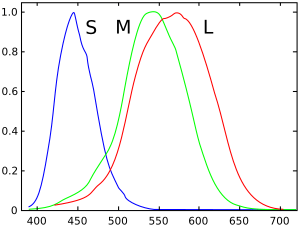Cone cell facts for kids
Cone cells, often just called cones, are tiny, special cells found in the retina at the back of your eye. They are super important because they help you see the world in full color! These cells work best when there's plenty of light around, like during the day.
Cone cells are not as good at seeing in dim light as another type of eye cell called rod cells. Rod cells are great for seeing in the dark, but they can't tell colors apart. Your human eyes usually have three different kinds of cone cells. This amazing setup allows your brain to see and understand all the different colors. Cone cells also react very quickly to changes, which means they help you see fine details and fast movements clearly.
How Cone Cells Help You See Color
The three types of human cone cells each have a special protein called a photopsin. Each photopsin reacts differently to light of various colors. Think of it like having three different color filters in your eye.
- One type of cone cell is most sensitive to red light.
- Another type is most sensitive to green light.
- The third type is most sensitive to blue light.
Because you have these three types of cones, you have what's called trichromatic vision. This means your brain mixes the signals from these three cones to create all the colors you see. If someone is color blind, it usually means one or two of their cone cell types aren't working correctly or are missing.
Number of Cone Cells
In 1935, a scientist named Osterberg estimated that a human eye has about 6 million cone cells. That's a lot of tiny cells working together to help you see!
Images for kids
-
Cone cells in the eyes of birds, reptiles, and monotremes (like the platypus).
See also
 In Spanish: Cono (célula) para niños
In Spanish: Cono (célula) para niños



